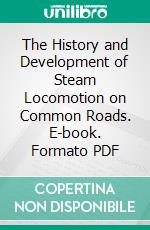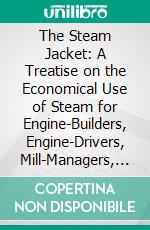William Fletcher eBooks
eBooks di William Fletcher
The History and Development of Steam Locomotion on Common Roads. E-book. Formato PDF William Fletcher - Forgotten Books, 2017 -
In dealing with Steam Transport on Common Roads the following division of the subject is usually adopted: -1. Road Locomotives for the conveyance of Passengers, Parcels, and light goods at quick speeds.2. Road Locomotives for Heavy Haulage and the conveyance of goods at slow speeds.3. Agricultural Locomotives for use on farms.In the present work the history of steam locomotion has been traced from the earliest down to modern times. The engines belonging to the first division being fully illustrated and described; the latter portion of the book also contains illustrations and much practical information relating to road locomotives placed under the second head.The book is divided into seven sections: -Introduction.The Period of Speculation.The Period of Experiment.The Period of Successful Application.The Modern Period.Practical Notes on the Design and Construction of Road Locomotives.Traction Engine Law.The first five sections are chiefly historical, the Modern Period, however, contains many useful notes and tables of dimensions.This work is a far more exhaustive treatise on this subject than has hitherto been attempted. There is not a book in existence which gives anything like a complete history of steam locomotion on common roads.
The Steam Jacket: A Treatise on the Economical Use of Steam for Engine-Builders, Engine-Drivers, Mill-Managers, and Steam-Users Genrally. E-book. Formato PDF William Fletcher - Forgotten Books, 2017 -
It may be owing to this dearth of literature, in a great measure, that accounts for such widespread ignorance respecting the use of the steam-jacket prevailing among engineers. It is to many a perplex ing paradox. When engine-makers, who do not apply it, evidence some hazy notions respecting its utility, there is no occasion for surprise. But, when we find engineers at the head of one of the largest portable engine firms (who profess to have jacketed their earliest engines, and still continue the practice) saying that the cylinder is protected from cold and radia tion by'means of a jacket of steam, clearly showing that the function of the steam-jacket is not understood by the writers, it does cause some astonishment. They can, be excused on the ground above named, viz., the fragmentary nature of the information relating to this subject. One writer says Almost every engineer knows now-a — days that a cylinder should be kept as hot as possible; but very few makers of steam-engines understand the precise reasons why a cylinder should be kept hot. 'most people imagine that the condensation takes place by conduction through the metal of the cylinder to the outside.

